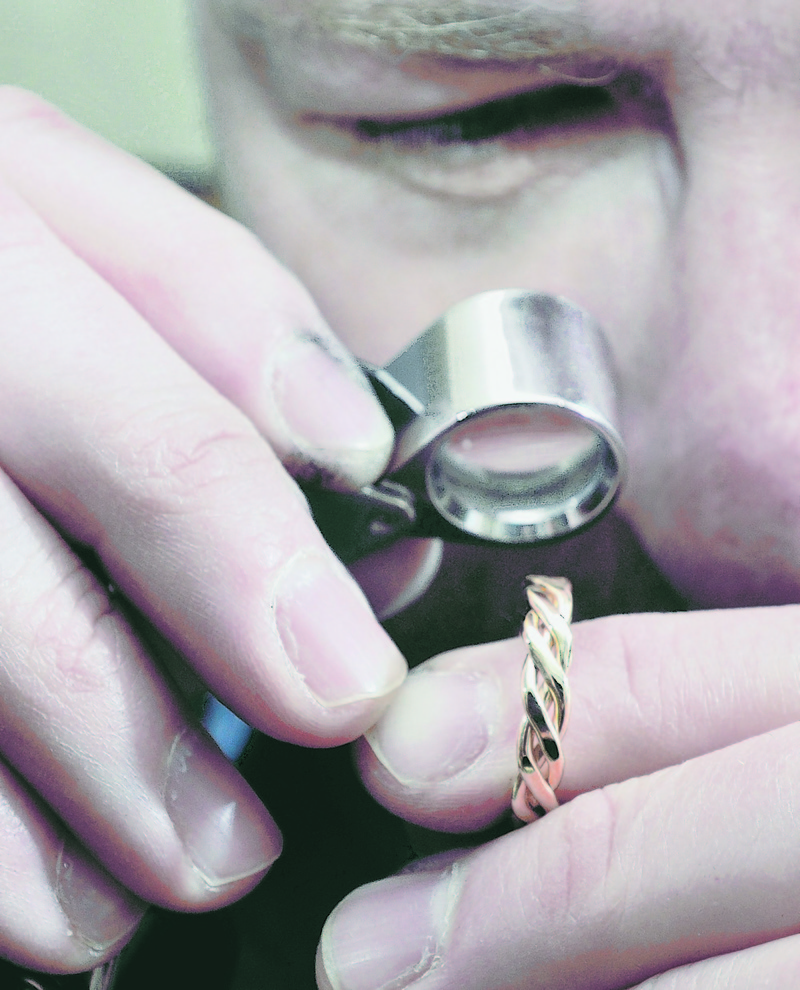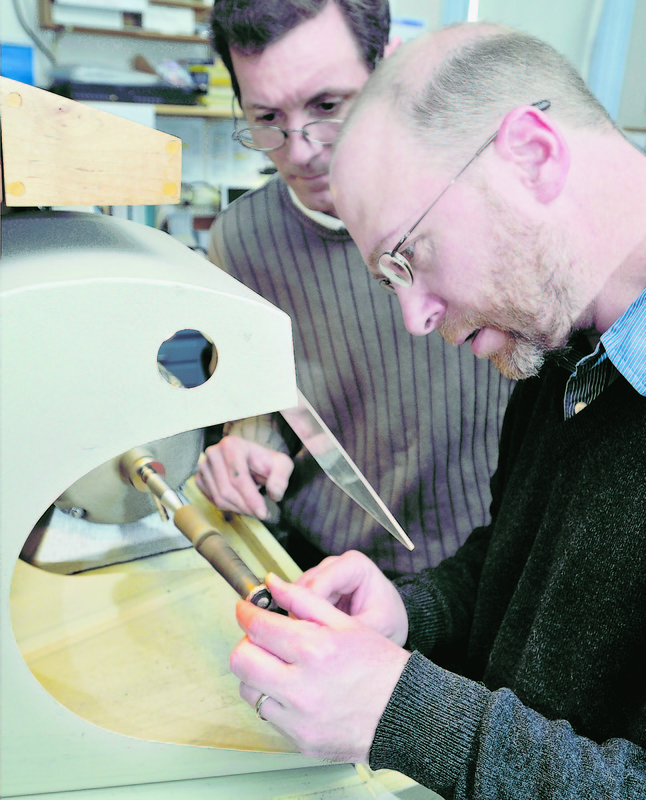FREEPORT — I looked at the foot-long length of wire in my hand – it looked like stereo speaker wire to me – and tried to wrap my mind around the fact that it was 14-karat gold.
“What we’re going to do is cut this wire into three pieces,” said Deane Frank, head jeweler at Brown Goldsmiths in Freeport, as he made two little marks on the wire with a red Sharpie. “Then we’re going to twist the three pieces together to make a twisted-rope pattern wedding band, for a man.”
Cut and twist gold? Isn’t gold too valuable to be cut and twisted? But I soon realized that jewelers couldn’t make intricate wedding bands – or pendants or chains, for that matter – unless they did a lot of delicate cutting, shaping and twisting of the gold.
“All this would be gold sheets that I’d have to cut into this pattern,” said Frank, showing me a drawing of an onyx pendant with a flurry of gold designs covering most of it. “So there’s a lot of cutting to be done there.”
Frank works in a small room upstairs from Brown Goldsmiths’ showroom. His wooden work bench has a decidedly old-fashioned, low-tech feel. It’s a wooden desk with a metal tray for catching pieces of hot solder, plus a soldering torch, several lamps and a huge array of files and cutting tools.
He sat me down at his bench last week, and told me I’d be able to make a rope pattern wedding band in about two hours, start to finish. Even with his help, I thought this would be tough. I’ve spent more time than that trying to cut out the clothes and accessories for just one of my daughter’s paper dolls.
The first thing Frank had me do was cut the gold wire into three pieces. I held the wire against a small wooden jig, then began cutting with a small handsaw that had a wire for a blade. I began sawing but got a little stuck.
“You want nice long strokes, straight up and down,” said Frank, watching me. “That’s it, you’re almost there.”
The wire was only 0.8 millimeters in diameter, but it seemed to take me five minutes to saw through it.
Once I got the three pieces cut, Frank bundled them together and used a laser (one of the few high-tech devices I saw) and quickly fused them at each end. Then he told me we’d have to solder them together.
I laid the bundle of wires on the little wooden jig again, and Frank used tweezers to put a tiny “chip” of soldering material (basically, melted gold) on each end of the bundle. Then he turned on the soldering torch.
When I asked how hot the blue flame was, he told me about 1,400 degrees.
That seemed unreal to me – my stove at home goes only to about 450.
“You want to make sure you solder over the metal tray,” Frank said. “You don’t want any hot solder falling onto your pants.”
No, I don’t.
GOLD TWISTED, CLEANED, HEATED
The trick, Frank told me, was to heat the solder enough to fasten the gold wires without melting or changing the shape of the gold wire in any way. And we shouldn’t use so much heat that the solder material liquefies completely.
“OK, now you can concentrate the flame a little more,” he said. “Oh, that’s bubbling, that’s a little too much.”
After the gold wire pieces were soldered, Frank told me to grab one end of the bundle of three wires with a pair of vise grips and stick the other end in a stationary vise.
Then I twisted the three strands of gold – it took some arm strength on my part – until they indeed looked like rope.
Then I put the gold rope through a rolling mill (two large metal cylinders cranked by hand) until it was flat. In between some of these steps, Frank cleaned the gold in various solutions and with a steam cleaner.
Back at the workbench, we heated the gold rope until it was pliable so I could start bending it into a ring shape.
I did this with my hands using a simple tool called a ring mandrel, a narrow metal cylinder with ring sizes marked on it. Once I had bent the gold enough to go completely around the mandrel, I had the size I wanted.
So I bent, cutting off excess as I went. Finally, we had a nearly finished ring, but with a little gap where the two ends of the gold rope needed to be attached.
Frank eyed this carefully for several minutes and worked the gold to make sure the rope patterns on each end would match. Then he used the laser to close the gap, and we soldered the ends together.
I held the tiny ring with both hands against the whirring brush used to polish the outside. That’s because Frank told me the brush spun so fast, it could grab the ring out of my hands and fling it violently back at me.
Not good.
AT THE END, A THING OF BEAUTY
Fortunately, there was a clear plastic shield between me and the brush.
The brush spun so fast, it made the ring hot in my hand. And the compound used to polish the gold left my hands full of black smudges.
I was amazed at how well the ring came out – all shiny and smooth and sparkling, with an intricate rope pattern that looked like it was carved with a tiny chisel.
Once the ring was cleaned, we brought it downstairs to the Brown Goldsmiths showroom and put it on a little finger-shaped stand in a glass display case. I was told it could sell for $625 to $650. Something I made is worth $650?
Earlier, Frank had told me he had practice teaching people to make wedding rings because Brown Goldsmiths has a wedding ring workshop where couples can come in and make their own bands, with Frank’s help.
Hearing that, I couldn’t help but think: “If I can do it, anyone can.”
Staff Writer Ray Routhier can be contacted at 791-6454 or at:
rrouthier@pressherald.com
Send questions/comments to the editors.





Success. Please wait for the page to reload. If the page does not reload within 5 seconds, please refresh the page.
Enter your email and password to access comments.
Hi, to comment on stories you must . This profile is in addition to your subscription and website login.
Already have a commenting profile? .
Invalid username/password.
Please check your email to confirm and complete your registration.
Only subscribers are eligible to post comments. Please subscribe or login first for digital access. Here’s why.
Use the form below to reset your password. When you've submitted your account email, we will send an email with a reset code.